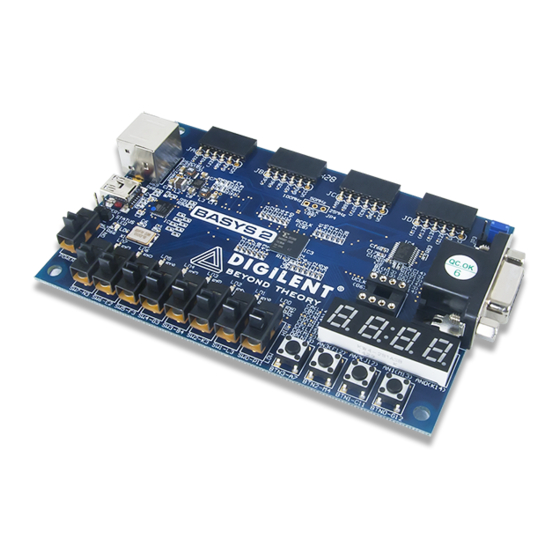Digilent Basys 2 Panduan Referensi - Halaman 4
Jelajahi secara online atau unduh pdf Panduan Referensi untuk Perangkat Keras Komputer Digilent Basys 2. Digilent Basys 2 12 halaman. Fpga board

Basys2™ FPGA Board Reference Manual
4
User I/O
Four pushbuttons and eight slide switches are provided for circuit inputs. Pushbutton inputs are normally low and
driven high only when the pushbutton is pressed. Slide switches generate constant high or low inputs depending
on position. Pushbuttons and slide switches all have series resistors for protection against short circuits (a short
circuit would occur if an FPGA pin assigned to a pushbutton or slide switch was inadvertently defined as an
output).
Eight LEDs and a four-digit seven-segment LED display are provided for circuit outputs. LED anodes are driven from
the FPGA via current-limiting resistors, so they will illuminate when a logic '1' is written to the corresponding FPGA
pin. A ninth LED is provided as a power-indicator LED, and a tenth LED (LD-D) illuminates any time the FPGA has
been successfully programmed.
4.1
Seven-segment display
Each of the four digits of the seven-segment LED display is composed of seven LED segments arranged in a "figure
8" pattern. Segment LEDs can be individually illuminated, so any one of 128 patterns can be displayed on a digit by
illuminating certain LED segments and leaving the others dark. Of these 128 possible patterns, the ten
corresponding to the decimal digits are the most useful.
The anodes of the seven LEDs forming each digit are tied together into one common anode circuit node, but the
LED cathodes remain separate. The common anode signals are available as four "digit enable" input signals to the
4-digit display. The cathodes of similar segments on all four displays are connected into seven circuit nodes labeled
CA through CG (so, for example, the four "D" cathodes from the four digits are grouped together into a single
circuit node called "CD"). These seven cathode signals are available as inputs to the 4-digit display. This signal
connection scheme creates a multiplexed display, where the cathode signals are common to all digits but they can
only illuminate the segments of the digit whose corresponding anode signal is asserted.
A scanning display controller circuit can be used to show a four-digit number on this display. This circuit drives the
anode signals and corresponding cathode patterns of each digit in a repeating, continuous succession, at an update
rate that is faster than the human eye response. Each digit is illuminated just one-quarter of the time, but because
the eye cannot perceive the darkening of a digit before it is illuminated again, the digit appears continuously
illuminated. If the update or "refresh" rate is slowed to a given point (around 45 hertz), then most people will
begin to see the display flicker.
Copyright Digilent, Inc. All rights reserved.
Other product and company names mentioned may be trademarks of their respective owners.
Page 4 of 12
